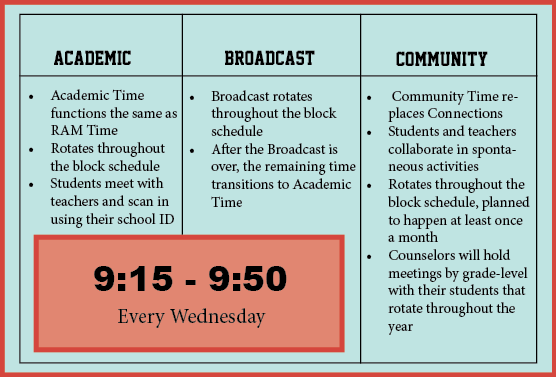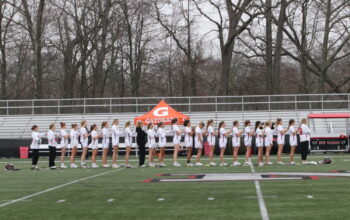Ryan Boulanger, News Editor
@RyanBCourant
For most staff and students the past few years have been marked with many changes, including the way emotional intelligence and learning has been approached. Integrating time for students to catch up on assignments and meet with teachers has always been a prime focus, but balancing that with meeting state mandated emotional learning standards has proven to be a challenge when considering the impact the pandemic had on the classroom dynamic.
Year after year, adjustments have been made in order to optimize all of the school’s goals, and with the introduction of this school year brings the arrival of a completely new schedule that incorporates all things students have enjoyed in the past; the Broadcast, RAM Time, along with a brand-new form of Connections called Community Time.
A team of teachers and administrators were put together to brainstorm, plan, and execute this year’s new schedule, affectionately dubbed the Building Block. English teacher Darcy Smith was at the forefront of the committee. “The origin of the Building Block began last spring when Principal Egan asked a few of us teachers for feedback on the initial Connections program,” said Ms. Smith.
Members of the team noticed many flaws in the old Connections model, and called for a redesign of the entire system. “Many of us agreed that instead of having two days a week of a special schedule, we should switch to having only one that also includes a flex block to accommodate all of the different needs that we have as a school,” said Ms. Smith.
Emotional intelligence has long been a topic of discussion in schools across the country, along with the introduction of a state mandate issued in 2020 calling for the integration of Social-Emotional learning programming into schools statewide. “The Connections program itself is something that came out of a state mandate,” said Ms. Smith. “Every school had to do something to incorporate Emotional intelligence into programming. We spent a few years trying out a few different models, such as staying in the classroom or in small, grade level groups.”
The ABC model is this year’s iteration, fine-tuned by veteran staff in order to maximize all aspects students and staff enjoyed from previous models. “The goal of the Community Block is to prioritize our needs and time, while creating a schedule of sorts to be followed,” said Ms. Smith. “A stands for Academic Time, when students can meet with teachers, B is for the Broadcast Time, and C is for Community Time. On Broadcast days, for example, we don’t know how long the Broadcast will be, it could be twelve minutes, it could be twenty. Whatever time remains in the block students becomes Academic Time for students to utilize.”
The goal of Emotional Intelligence programming has always been to forge open relationships between students and staff. English teacher Arri Weeks, a member of the Building Block team, hopes that the brand-new Community Time will help create more genuine student-teacher camaraderie. “We thought the most effective way to bring together students and teachers was through activities, rather than Emotional Intelligence instruction,” said Ms. Weeks. “Instead of lessons about connecting, let’s actually connect.”
Community Time, the new configuration of the old Connections Block, was created with the end goal of allowing natural relationships to manifest in an open environment as opposed to one of academic instruction. “Making connections between teachers and their existing students is crucial, and I think it’s important for every student in the building to feel comfortable all of the time. Knowing the nature of humans, that might not always be the case, but I think if every student has at least one adult in the building they feel comfortable with, we’d be better off,” said Ms. Smith. “And it’s not necessarily that a student has to have a problem to feel comfortable with a teacher, even just building those relationships is key because school is where we all spend our time.”
In the transition to a classroom focused model, the Building Block team aims for the connections previously formed with other adults to now be driven towards teachers that students actually have. “I enjoyed having my old Connections group last year, and liked the connections I formed with each of them,” said Ms. Weeks. “We hoped this year to form those connections by staying with the teachers students actually have, because a lot of times it’s very in-and-out with teachers, but we teachers really do want to get to know and help our students.”
Logistically, the Building Block bridges the gap in last year’s model between Ram Time Tuesdays and special schedule Fridays. Assistant Principal Lawrence Sullivan provided insight from an administrative perspective. “We wanted to continue with some form of beyond the classroom connection between kids and teachers, but realized that the existing format we had for Connections wasn’t the most effective way to do it,” said Mr. Sullivan. “A big thing teachers struggled with was having two varied schedules during the week. We wanted to bring those two into sync, and have one day during the week that was a different schedule.”
The Building Block team gathered student insight in order to devise a plan that would oblige both students and staff. “We tried to take those two disparate schedules and put them together in a way that was meaningful to both students and faculty,” said Mr. Sullivan.
“We reacted to some of the polling we had done with students about how they were seeing connections and whether they preferred the idea of breaking apart separately into a group as we did last year, opposed to staying with the teacher you already had and the classmates you already knew,” he added.
Mr. Sullivan commended both Ms. Smith and Ms. Weeks for their tireless efforts to bring the Building Block to life, along with the many others who helped. “We started some discussions last May, and particularly Ms. Smith and Ms. Weeks put a lot of work this summer into devising the model,” said Mr. Sullivan.
Teacher involvement spanned across multiple departments. “They were not alone in this process, we met as a committee, which I was a part of, Dr. Susan Bliss, our district-wide student support coordinator, as well as Ms. Sara Drexel, Ms. Sarah Gleeson, Mr. Michael Tiscia, and others,” he added.
The Building Block team is continuing to look out for both teacher and student feedback. The team plans to send out polls in late November to gather information from the first few cycles of the new model in order to tweak it as the academic year progresses.




